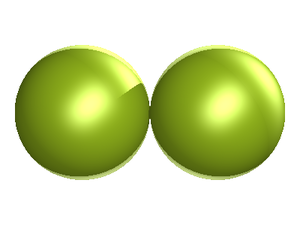Hard dumbbell model: Difference between revisions
Jump to navigation
Jump to search
mNo edit summary |
m (Added link to code F.16) |
||
| Line 6: | Line 6: | ||
==References== | ==References== | ||
#[http://dx.doi.org/10.1063/1.1748236 A. Isihara "Theory of High Polymer Solutions (The Dumbbell Model)", Journal of Chemical Physics '''19''' pp. 397- (1951)] | #[http://dx.doi.org/10.1063/1.1748236 A. Isihara "Theory of High Polymer Solutions (The Dumbbell Model)", Journal of Chemical Physics '''19''' pp. 397- (1951)] | ||
==External resources== | |||
*[ftp://ftp.dl.ac.uk/ccp5/ALLEN_TILDESLEY/F.16 Hard dumb-bell Monte Carlo program] sample FORTRAN computer code from the book [http://www.oup.com/uk/catalogue/?ci=9780198556459 M. P. Allen and D. J. Tildesley "Computer Simulation of Liquids", Oxford University Press (1989)]. | |||
[[Category: Models]] | [[Category: Models]] | ||
Revision as of 19:30, 8 February 2009

The Hard dumbbell model consists of two hard spheres separated by a distance .
Equation of state
- Main article: Equation of state for the hard dumbbell model
References
External resources
- Hard dumb-bell Monte Carlo program sample FORTRAN computer code from the book M. P. Allen and D. J. Tildesley "Computer Simulation of Liquids", Oxford University Press (1989).
